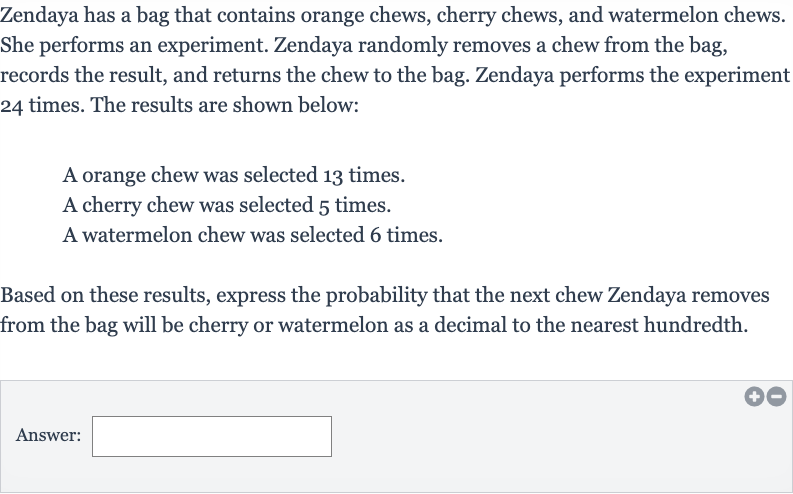AI tutor
Welcome to Bytelearn!
Let’s check out your problem:

Zendaya has a bag that contains orange chews, cherry chews, and watermelon chews. She performs an experiment. Zendaya randomly removes a chew from the bag, records the result, and returns the chew to the bag. Zendaya performs the experiment times. The results are shown below:A orange chew was selected times.A cherry chew was selected times.A watermelon chew was selected times.Based on these results, express the probability that the next chew Zendaya removes from the bag will be cherry or watermelon as a decimal to the nearest hundredth.Answer:
Full solution
Q. Zendaya has a bag that contains orange chews, cherry chews, and watermelon chews. She performs an experiment. Zendaya randomly removes a chew from the bag, records the result, and returns the chew to the bag. Zendaya performs the experiment times. The results are shown below:A orange chew was selected times.A cherry chew was selected times.A watermelon chew was selected times.Based on these results, express the probability that the next chew Zendaya removes from the bag will be cherry or watermelon as a decimal to the nearest hundredth.Answer:
- Calculate Total Selections: To find the probability of an event, we divide the number of times the event occurs by the total number of trials. In this case, we want to find the probability of selecting either a cherry or watermelon chew.
- Find Total Experiments: First, we need to determine the total number of times a cherry or watermelon chew was selected. We add the number of times a cherry chew was selected to the number of times a watermelon chew was selected. (cherry) + (watermelon) =
- Calculate Probability: Next, we need to find the total number of experiments conducted, which is given as .
- Convert to Decimal: Now, we calculate the probability of selecting either a cherry or watermelon chew by dividing the combined number of times these chews were selected by the total number of experiments.Probability = Number of cherry or watermelon chews selected / Total number of experimentsProbability =
- Convert to Decimal: Now, we calculate the probability of selecting either a cherry or watermelon chew by dividing the combined number of times these chews were selected by the total number of experiments.Probability = Number of cherry or watermelon chews selected / Total number of experimentsProbability = Finally, we convert this fraction to a decimal and round it to the nearest hundredth.Probability (as a decimal) = Rounded to the nearest hundredth, the probability is .
More problems from Find probabilities using the binomial distribution
QuestionGet tutor help
QuestionGet tutor help
QuestionGet tutor help
QuestionGet tutor help
QuestionGet tutor help
QuestionGet tutor help
QuestionGet tutor help
QuestionGet tutor help
QuestionGet tutor help
QuestionGet tutor help
